|
|
(This is an brief part of the E-Book on Cowichan Bay, click here for the actual book)
Please take a minute and visit my sponsor... http://cowichanbay.net
First of all, let's put the start of Cowichan Bay into historical perspective. The California Gold Rush was in 1848. Chicago World's Fair and the opening of the San Francisco Cable Cars in 1873. Custer's Last Stand was in 1876 and the Alaska Gold Rush started in 1880.
Early dates for Cowichan Bay start about 1850 when Captain Richards on board the HMS Plumper started naming the area. The profile of the British Admiralty has always been high in the Gulf Islands and surrounding waters. A lot of the activity actually went back to the Slave Trade when Britain sent ships in an effort to stem the trade. As well there a was a lot of concern about the growing influence of the American colonies. It is a bloody good thing that the British presence was here or we could indeed all be Americans here too. When the real boundaries for Canada were finally drawn up Vancouver Island's southern tip was kept in Canada as Victoria (well below the 49th parallel) was an important city. If New Westminster was made the capital everything from Ladysmith south (including the Gulf Islands) could have been American. Many native Indian names remain, along with a number of Spanish ships and explorers. But, the mark of history in this area is definitely British. And, we must not forget the influence the Hudson’s Bay Company had as well.
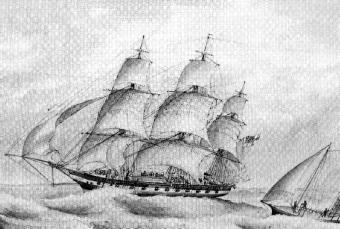 Cowichan Bay, and a lot of the area also owes considerable debt to
the Governor of the time. Governor Douglas had a policy regarding the security
of settlers. Quite simply, any hostile acts by the natives were dealt with
rapidly and severely. September 1856 saw the hanging of a local native for
the murder of a settler. He had the warship Trincomalee towed up from Victoria
by the Hudson’s Bay steam vessel Otter. Over 400 able bodied seamen
showed up in Cowichan Bay and demanded justice of the local Indians. They
were all too eager to comply, that was a bloody big ship with a lot of cannons!
Cowichan Bay, and a lot of the area also owes considerable debt to
the Governor of the time. Governor Douglas had a policy regarding the security
of settlers. Quite simply, any hostile acts by the natives were dealt with
rapidly and severely. September 1856 saw the hanging of a local native for
the murder of a settler. He had the warship Trincomalee towed up from Victoria
by the Hudson’s Bay steam vessel Otter. Over 400 able bodied seamen
showed up in Cowichan Bay and demanded justice of the local Indians. They
were all too eager to comply, that was a bloody big ship with a lot of cannons!
In 1858 the Hudson’s Bay Company started selling land in what
became Cowichan Bay. I am not sure if the Colonist has archives that far
back, but the July 11, 1859 issue published a list of investors. Settlement
started in earnest about 1861. Plans were drawn up for the town that even
included a jail. At this point we almost missed being called Harrisville.
The fellow that started most of the activity was Samuel Harris, the first
"special constable" for the area.  The first public house
was his John Bull Inn, naturally a well stocked bar, dock, and the aforementioned
jail's real predecessor. He started the process of designing the town and
retained a surveyer named Otty to do the work. The love affair with the
area did not last long though. Disenchanted over his appointment and salary
as the "long arm of the law", he sold his property to Giovanni
Baptiste Ordano, an Italian immigrant who named Genoa Bay after his home
town in Italy. Many pictures of famous folk at the Ordano Boat Rentals exist.
This was the most popular salmon fishing area of the time for all the rich
movie stars. Long before Campbell River...
The first public house
was his John Bull Inn, naturally a well stocked bar, dock, and the aforementioned
jail's real predecessor. He started the process of designing the town and
retained a surveyer named Otty to do the work. The love affair with the
area did not last long though. Disenchanted over his appointment and salary
as the "long arm of the law", he sold his property to Giovanni
Baptiste Ordano, an Italian immigrant who named Genoa Bay after his home
town in Italy. Many pictures of famous folk at the Ordano Boat Rentals exist.
This was the most popular salmon fishing area of the time for all the rich
movie stars. Long before Campbell River...
The location of the town in a natural harbour naturally dictated that it would be a seacoast development. Up the Cowichan River the town of Duncan would be founded, but it would be the more stable farmers and trappers that set the theme there. Like Cowichan Bay, Duncan almost missed being called Alderlea the name of the farm that was the location of the town. So named for its abundance of Alder Trees I asume. And then there is logging... Naturally our location here made it ideal for sawmills, and logging activities.
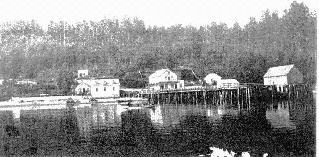 As well, we have the coaches and wagons to and from Victoria. Whenever anyone
thinks about stage coaches they think about the “Wild West”. But
in fact the east side of Vancouver Island was a major wagon route. Even
though we had sea transport, a lot of movement was by land from Victoria.
Coal from Nanaimo, lumber, all went by road as the railway was not even
thought of then. Picture shows the original Store, Post Office, Government
Dock with the Columbia Hotel in the background. With the exception of the
old road from Sooke up to Shawnigan lake nearly all of these roads survive.
The travellers needed food and accommodation so a number of “Road Houses”
were developed to accommodate them. Cowichan Bay was no exception, and the
Masthead owes its existence to it. In 1868 it was built as the Columbia
Hotel. Very little change has happened to the structure since then, with
the exception of a new foundation. Of course, it has not been a hotel for
a long time, being converted to a fine restaurant, an upstairs apartment
and a few businesses in the lower area. But, it pretty well qualifies as
the oldest remaining building in town.
As well, we have the coaches and wagons to and from Victoria. Whenever anyone
thinks about stage coaches they think about the “Wild West”. But
in fact the east side of Vancouver Island was a major wagon route. Even
though we had sea transport, a lot of movement was by land from Victoria.
Coal from Nanaimo, lumber, all went by road as the railway was not even
thought of then. Picture shows the original Store, Post Office, Government
Dock with the Columbia Hotel in the background. With the exception of the
old road from Sooke up to Shawnigan lake nearly all of these roads survive.
The travellers needed food and accommodation so a number of “Road Houses”
were developed to accommodate them. Cowichan Bay was no exception, and the
Masthead owes its existence to it. In 1868 it was built as the Columbia
Hotel. Very little change has happened to the structure since then, with
the exception of a new foundation. Of course, it has not been a hotel for
a long time, being converted to a fine restaurant, an upstairs apartment
and a few businesses in the lower area. But, it pretty well qualifies as
the oldest remaining building in town.
Over the years fishing and logging figured prominently. The logging inland has more or less remained, but the fishing has died off. The best stories are told about the fishing times and folk. Famous folk like Bing Crosby, Hopalong Cassidy (a.k.a. William Boyd), Bob Hope, and John Wayne to name just a few. They could all be found at the Buena Vista Hotel at one time.
We had a pet whale here. A grey whale lived in the bay for years and was so tame that folk would scrub him with a mop.
Then there is the story of "the boat that would not sink"... Seems that the government in order to increase the fishing fleet offered considerable cash to anyone building a fishing boat. One of the more "colorful" folk decided to build a boat, purely for the cash value. So, it used the poorest materials, and was never intended to actually be used. But, nevertheless it was built. Then it was decided to destroy it and claim the loss. The engine room was torched. Well, the water came in and put out the fire. A hole was drilled in an attempt to sink it. The bloody thing just sank into the water and refused to go under. Maybe some lessons should have been taken from this one, perhaps it was a better design than anyone ever intended.
But, we digress from the historical aspect. There will be more on the anecdotes once my book is finished!
 Growth and development
in Cowichan Bay pretty well evolved by the nature of the area. The fact
that it was a good harbour dictated that logging should be a part of it.
Forests up the Cowichan River were some of the best anywhere. And it was
a short down hill trip to Cowichan Bay. The railway made that easy. But,
a try was made at floating the logs down the Cowichan River. A total disaster
to both the logs and the river banks. There was almost as much ship activity
on Cowichan Lake as there was here at one point. Logs were boomed by steam
tugs, loaded on railcars and brought directly to the bay. Today there is
still an active sawmill and shipping facility for lumber. My charts still
show the rail line to the dock, but roads and trucking have taken over.
The rail line up to Cowichan Lake is long gone. The pilings and dolphins
(moorage thingees, not fish) still exist. Logs are no longer brought down
from the lake, but arrive by boom every week. Falt Towing tugboats have
been here for 25 plus years working the area. Al Falt recently told me the
story of his early days when he was a deckhand working the booms. Hopalong
Cassidy, was down on the shore with a bunch of buddies. They were doing
some home movies and had watched Al working the booms. They requested that
Al fake a fall into “The Chuck” for them. History here declines
to record if he complied with the request. The plaque commemorating the
early settlers is clickable...
Growth and development
in Cowichan Bay pretty well evolved by the nature of the area. The fact
that it was a good harbour dictated that logging should be a part of it.
Forests up the Cowichan River were some of the best anywhere. And it was
a short down hill trip to Cowichan Bay. The railway made that easy. But,
a try was made at floating the logs down the Cowichan River. A total disaster
to both the logs and the river banks. There was almost as much ship activity
on Cowichan Lake as there was here at one point. Logs were boomed by steam
tugs, loaded on railcars and brought directly to the bay. Today there is
still an active sawmill and shipping facility for lumber. My charts still
show the rail line to the dock, but roads and trucking have taken over.
The rail line up to Cowichan Lake is long gone. The pilings and dolphins
(moorage thingees, not fish) still exist. Logs are no longer brought down
from the lake, but arrive by boom every week. Falt Towing tugboats have
been here for 25 plus years working the area. Al Falt recently told me the
story of his early days when he was a deckhand working the booms. Hopalong
Cassidy, was down on the shore with a bunch of buddies. They were doing
some home movies and had watched Al working the booms. They requested that
Al fake a fall into “The Chuck” for them. History here declines
to record if he complied with the request. The plaque commemorating the
early settlers is clickable...
 Regarding sport fishing, this was one of the best salmon fishing areas
anywhere at the time. As it was close to the US a lot of famous Americans
showed up here. Seaplanes flew fishermen in almost hourly when the salmon
were running. John Wayne and others had boats so came here regularly. The
"Hangout" was the Buena Vista Hotel (picture at right). It was
located between Wilmot and Pritchard right on the corner of the Bay Road
(up from the Masthead on the corner where the apartment block is now). Naturally
it had a magnificent bar where everyone gathered. It was the place to stay
in the area. No trace of the original remains to this day, it burned to
the ground in a rather mysterious way. Well, in truth, not too mysteriously.
A couple of days prior some folk who tried to register were told that they
were not taking any registrations. Just before the fire the owner was seen
removing the cash register. The owner was tried and duly convicted of torching
his place. Now there is an apartment on the site. The full story of the
trial and subsequent conviction will be left to a later chapter.
Regarding sport fishing, this was one of the best salmon fishing areas
anywhere at the time. As it was close to the US a lot of famous Americans
showed up here. Seaplanes flew fishermen in almost hourly when the salmon
were running. John Wayne and others had boats so came here regularly. The
"Hangout" was the Buena Vista Hotel (picture at right). It was
located between Wilmot and Pritchard right on the corner of the Bay Road
(up from the Masthead on the corner where the apartment block is now). Naturally
it had a magnificent bar where everyone gathered. It was the place to stay
in the area. No trace of the original remains to this day, it burned to
the ground in a rather mysterious way. Well, in truth, not too mysteriously.
A couple of days prior some folk who tried to register were told that they
were not taking any registrations. Just before the fire the owner was seen
removing the cash register. The owner was tried and duly convicted of torching
his place. Now there is an apartment on the site. The full story of the
trial and subsequent conviction will be left to a later chapter.
What is now the Fisherman's Dock (a.k.a. The Government Dock) was built by the Provincial Government. These docks were built all over the province to support the shipping of goods up and down the coast. They are easily spotted by the red handrails on them. Many Missions were established on the west coast of British Columbia, and an entire of fleet of ships were maintained to serve them. Some of these vessels still exist to this day and are magnificent old boats. But, the increasing importance of commercial fisheries resulted in the docks being sold or transferred to the now Federal Government. By this time British Columbia had joined the federation and the railway and industry had arrived on the west coast. In January 1954 the government docks were transferred to Federal control. At that time the main dock and the breakwater existed. Pictures of that time show there was only a small dock behind it, large enough to accommodate a handful of boats. It has since been dredged to accommodate deep draft vessels in most tides. The docks to the west were added at a later date and the Masthead dock was completely re-stuctured. At that time all the property up the hill to the left (where the Resort Hotel now sits) was 20 to 25 foot property parcels. What is now the pub was then the old Harris market, pub and post office.
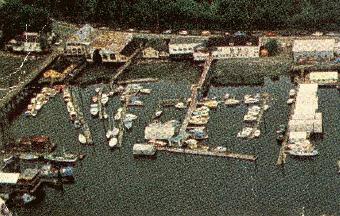 Moving down to the west, the Hotel had a sort of angled dock (seen
on picture at right). Due to the shallow water smaller boats gravitated
to this area. As well, there were a number of “float houses” where
the west section of the government dock now sits. My pictures from the 50’s
show a large floating structure right next to the government dock behind
the Masthead. This building had a lot of incarnations, the most memorable
was as a Chandlery owned by John Mack. It was single handed dis-assembled
by one of the present residents and used to build her float house (still
in the same position as the original Chandlery).
Moving down to the west, the Hotel had a sort of angled dock (seen
on picture at right). Due to the shallow water smaller boats gravitated
to this area. As well, there were a number of “float houses” where
the west section of the government dock now sits. My pictures from the 50’s
show a large floating structure right next to the government dock behind
the Masthead. This building had a lot of incarnations, the most memorable
was as a Chandlery owned by John Mack. It was single handed dis-assembled
by one of the present residents and used to build her float house (still
in the same position as the original Chandlery).
Shipbuilding as mentioned earlier figured prominently in the history. So, the next building to the Masthead would naturally be the only surviving shipbuilders. The Cowichan Bay Shipyard was established in the 1800's and exists largely in the same form today. With the exception of emphasis on repair and restoration. I rather enjoyed looking at some of the interior. I appreciate old machines, and a lot of the very old “tools of the trade” are still in use today. All in fine working shape. And that includes wooden hand tools too! The owner’s have maintained not just a building but an archive of the way we used to do things. New does not always mean better!
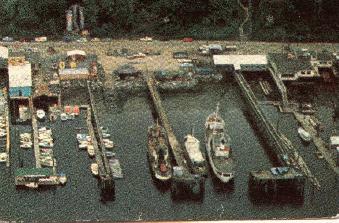 At one time deep sea vessels, both of a commercial and a military nature
came to what we now refer to as “Cow Bay”. So, the long history
of the Admiralty showing up here has been perpetuated. One of the locals
Ray, started coming here aboard the Royal Navy, and eventually wound up
living here. I am certain he emigrated, and didn't just “jump ship”.
Like the rest of this bit of research, a great number of his stories have/will
appear here. A place like this relies heavily on the long term residents
of the past and present. All of which I hope to talk to or write about.
Picture shows the deep water section of the harbour and some of the refueling
and loading facilities around 1955.
At one time deep sea vessels, both of a commercial and a military nature
came to what we now refer to as “Cow Bay”. So, the long history
of the Admiralty showing up here has been perpetuated. One of the locals
Ray, started coming here aboard the Royal Navy, and eventually wound up
living here. I am certain he emigrated, and didn't just “jump ship”.
Like the rest of this bit of research, a great number of his stories have/will
appear here. A place like this relies heavily on the long term residents
of the past and present. All of which I hope to talk to or write about.
Picture shows the deep water section of the harbour and some of the refueling
and loading facilities around 1955.
But, I digress (again).
In the 50’s this was a major area on the West Coast. All the major oil companies at the time, some by the same name (Shell Oil) and others by names long gone (British American Petroleum) had refueling facilities. Pier 66 in those days had the same look as today from the water. But it was only one of a number of places to fuel up for the “big boys”. Docks existed that accommodated ships of considerable draft.
Coast Shipyards had yet to be established as we knew it, but there was a marine way there that could handle quite a number of large boats. The ways still exist, but new streetside buildings are there now (if you can call 40 year old buildings new).
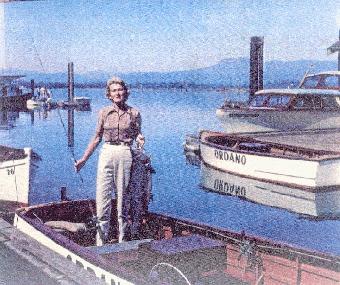 The Bay rapidly established itself as a sort of resort. Duncan not
having any access to the water gravitated to this area for it's recreation.
Ordano's Boathouse catered to the sport fishermen of the day. The farm at
the top of the bay was there, and beside it the Corfield family store. History
relates that Robert W. Service wrote most of his material here before he
went to the north. The actual territory of Cowichan Bay goes from the water
well up to where the highway is now. That included a number of farms. Some
of which are still owned by the same family. Hill’s Indian Crafts was
started by Mrs. Hill, a local resident who to this day is still alive. She
virtually put the Cowichan Indian sweaters on the map. I still have folk
in California who regularly mention that they have one. A number of ladies
from the Cowichan Band (sorry, I have not confirmed the spelling of the
new nation’s name) still knit directly for this market. No patterns
exist for the real items, only tradition designs in the knitter’s memory
are used.
The Bay rapidly established itself as a sort of resort. Duncan not
having any access to the water gravitated to this area for it's recreation.
Ordano's Boathouse catered to the sport fishermen of the day. The farm at
the top of the bay was there, and beside it the Corfield family store. History
relates that Robert W. Service wrote most of his material here before he
went to the north. The actual territory of Cowichan Bay goes from the water
well up to where the highway is now. That included a number of farms. Some
of which are still owned by the same family. Hill’s Indian Crafts was
started by Mrs. Hill, a local resident who to this day is still alive. She
virtually put the Cowichan Indian sweaters on the map. I still have folk
in California who regularly mention that they have one. A number of ladies
from the Cowichan Band (sorry, I have not confirmed the spelling of the
new nation’s name) still knit directly for this market. No patterns
exist for the real items, only tradition designs in the knitter’s memory
are used.
Older residents all relate the stories of community activities. The old fire hall was the center of all the “fun and games”. Dances and games were the order of the day. Everyone knew everyone and the community spirit was vital and alive. There were a lot of "British Folk" living in the area, so polo naturally was played on the old farm property. The South Cowichan Lawn Tennis club, started in 1888 is the second oldest club in the world (next to Wimbledon itself).
 The story of the "Butter Church" is probably one of the saddest
tales we have around here. Click here for a brief
history and more pictures.
The story of the "Butter Church" is probably one of the saddest
tales we have around here. Click here for a brief
history and more pictures.
It is a pretty well forgotten fact that there was a village up near the St. Ann's Church. The village of Tzouhalem died off completely during the war.
Eventually the commercial nature of the bay started to disappear. The Bluenose was built by Al Falt., mentioned earlier. At the other end of town where the Inn At The Water Hotel is now (or whatever the new owner will rename it) was a once cozy resort with a salt water swimming pool. The present resort has had a number of owners over the years, some of which were quite famous (Tommy Hunter) and a few who were infamous (sorry, no good gossip forthcoming). Originally built to be luxury recreational development it has had a very tough time in the last few years, and is presently closed.
A number of Bed and Breakfast places exist. One right across the street from the Inn At The Water. The Dream Weaver, was built with a particularly stunning old style charm. At the other end of town we have the Wessex, a rather Victorian Inn style building. And between a number of cozy places right on the water. From my vantage I rather enjoy one of the houses who have what I refer to as a "floating patio". A bit of a deck with a motor that they sail out into the bay on nice summer evenings.
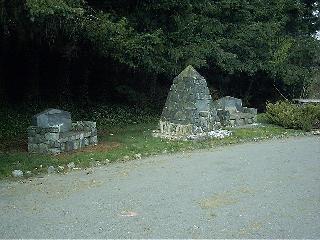 Back to the subject of Robert W. Service.
There are a group of stone monuments in the area of the old bridge that
used to cross the river near the Corfield farm and store. Click on the image
at right for a closeup of the plaque that is on the bench commemorating
Service. Plans have been discussed to have an annual day commemorating the
fact that he started here in Cowichan Bay.
Back to the subject of Robert W. Service.
There are a group of stone monuments in the area of the old bridge that
used to cross the river near the Corfield farm and store. Click on the image
at right for a closeup of the plaque that is on the bench commemorating
Service. Plans have been discussed to have an annual day commemorating the
fact that he started here in Cowichan Bay.
I have not finished all my research, so this is a "Work In Progress". There is a lot of work still to do. What started off as a simple website will eventually be a book on The Bay.
The new year is upon me, and the sailing season is just getting started. I have been rather slow on the research, but am plugging along. Meantime, if you have a story or some pictures that might be of interest I would really like to hear from you. You can email me, or call me on the phone. Call me at 701-0343 and we can talk. Or just flag me down. When the arthritis acts up I have to use my cane, so that kind of makes me a bit distinctive...
Tom, the Traveling Writer.
Photos and images courtesy of:
|